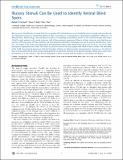| dc.contributor.author | Crossland, Michael D. | |
| dc.contributor.author | Dakin, Steven C. | |
| dc.contributor.author | Bex, Peter | |
| dc.date.accessioned | 2011-01-14T15:56:58Z | |
| dc.date.issued | 2007 | |
| dc.identifier.citation | Crossland, Michael D., Steven C. Dakin, and Peter J. Bex. 2007. Illusory Stimuli Can Be Used to Identify Retinal Blind Spots. PLoS ONE 2(10): e1060. | en_US |
| dc.identifier.issn | 1932-6203 | en_US |
| dc.identifier.uri | http://nrs.harvard.edu/urn-3:HUL.InstRepos:4661592 | |
| dc.description.abstract | Background: Identification of visual field loss in people with retinal disease is not straightforward as people with eye disease are frequently unaware of substantial deficits in their visual field, as a consequence of perceptual completion (“filling-in”) of affected areas. Methodology: We attempted to induce a compelling visual illusion known as the induced twinkle after-effect (TwAE) in eight patients with retinal scotomas. Half of these patients experience filling-in of their scotomas such that they are unaware of the presence of their scotoma, and conventional campimetric techniques can not be used to identify their vision loss. The region of the TwAE was compared to microperimetry maps of the retinal lesion. Principal Findings: Six of our eight participants experienced the TwAE. This effect occurred in three of the four people who filled-in their scotoma. The boundary of the TwAE showed good agreement with the boundary of lesion, as determined by microperimetry. Conclusion: For the first time, we have determined vision loss by asking patients to report the presence of an illusory percept in blind areas, rather than the absence of a real stimulus. This illusory technique is quick, accurate and not subject to the effects of filling-in. | en_US |
| dc.language.iso | en_US | en_US |
| dc.publisher | Public Library of Science | en_US |
| dc.relation.isversionof | doi:10.1371/journal.pone.0001060 | en_US |
| dc.relation.hasversion | http://www.ncbi.nlm.nih.gov/pmc/articles/PMC2020442/pdf/ | en_US |
| dash.license | LAA | |
| dc.subject | neuroscience | en_US |
| dc.subject | cognitive neuroscience | en_US |
| dc.subject | sensory systems | en_US |
| dc.subject | ophthalmology | en_US |
| dc.subject | retinal disorders | en_US |
| dc.title | Illusory Stimuli Can Be Used to Identify Retinal Blind Spots | en_US |
| dc.type | Journal Article | en_US |
| dc.description.version | Version of Record | en_US |
| dc.relation.journal | PLoS ONE | en_US |
| dash.depositing.author | Bex, Peter | |
| dc.date.available | 2011-01-14T15:56:58Z | |
| dash.affiliation.other | HMS^Ophthalmology | en_US |
| dc.identifier.doi | 10.1371/journal.pone.0001060 | * |
| dash.contributor.affiliated | Bex, Peter | |


